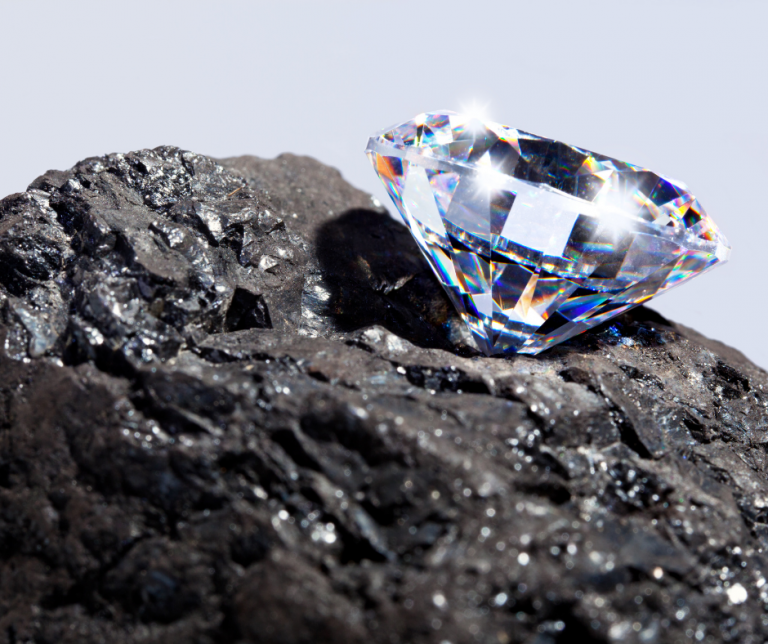Ask the Experts: Diamonds 101
What are the differences between lab-grown and natural diamonds?

During the last several years, lab-grown diamonds have received a lot of attention. Reasons for their popularity include their price, sustainability, and durability. To the naked eye, it is fairly hard to tell the difference between a lab-grown and natural diamond. Many feel that manufactured diamonds aren’t considered “real” diamonds, however, we believe this to be a fallacy. Lab-grown diamonds have remarkably similar clarity grades, natural inclusions, and properties to those of natural diamonds. When deciding on which type of diamond you should purchase, you’ll want to consider all the advantages and drawbacks of choosing a lab-grown diamond over a classic, mined diamond.
What is a Lab-grown Diamond?
Unlike cubic zirconia, white sapphire, and moissanite, diamonds grown in a lab are in fact real. The main difference between natural diamonds and lab-grown diamonds is the origin in which they are created. Most commonly, lab-grown diamonds are made using two types of methods: high pressure, high temperature (HPHT), and chemical vapor deposition (CVD).
An HPHT diamond is formed by imitating the process that natural diamonds go through within the earth. It starts with a small diamond seed made of carbon atoms. The seed is put into a carbon source like graphite or diamond powder and endures high heat and extreme pressure. Once the pure carbon starts to melt, a diamond forms around the starter diamond seed. From there, the diamond is cooled, cut, and refined.
A CVD diamond is formed by taking a tiny fragment of a diamond seed and placing it into a carbon-rich gas mixture in a gas chamber where it is heated to 800 degrees Celsius. The gases are ionized into plasma and the pure carbon attaches to the original diamond seed. As the carbon continues to build, a new, larger diamond is formed.
Both above types manufactured diamonds are almost identical to natural diamonds in their appearance.
What are the Advantages of Purchasing Lab-grown Diamonds?
Believe it or not, lab-grown diamonds are graded and certified on the same scale as natural diamonds. A few diamond certification labs you may be familiar with include the Gemological Institute of America (GIA), Gem Certification & Assurance Lab (GCAL), and International Gemological Institute (IGI). These organizations look for the four C’s (color, cut, clarity, and carat), and accredit each lab-grown diamond accordingly.
Benefits to opting for a manufactured diamond include:
- Price. Because lab-grown diamonds don’t have to go through the same supply chain demands of a mined diamond, often they can be less expensive and easier to find in the style you are looking for. By no means are lab-grown diamonds considered an “outlet item,” however they may save you a healthy chunk of change.
- Sustainability & Ethical Responsibility. Some natural diamonds are still mined in a dangerous way, which can initiate violence and turmoil among minors and their families. When purchasing a lab-grown diamond, you can feel good knowing that there was no harm or conflict during the creation and production process. Additionally, most companies specializing in lab-grown diamonds pride themselves in doing everything possible to remain environmentally conscious and cruelty-free.
- Durability. Just like mined diamonds, the quality of lab-grown diamonds won’t change or deteriorate over time. In fact, lab-grown diamonds are just as hard, strong, and durable as natural diamonds and rank a 10 on the Mohs Hardness Scale. Lab-grown diamonds also test positive on a diamond tester because they are made of crystallized carbon.
What are the Disadvantages of Purchasing Lab-grown Diamonds?
Most expert gemologists have a hard time differentiating between lab-grown and natural diamonds. A series of tests must be performed to identify the derivation of the diamond. When you are out and about, it is likely that no one will be able to tell whether the diamond you are wearing is lab-grown or natural. With that said, there are a couple of drawbacks to purchasing a lab-grown diamond over a traditional one.
- Long-term Value. Lab-grown diamonds are considered “new” to the jewelry and gemstone industry. Because of this, a set long-term value has not been determined yet and a lab-grown diamond may not hold as much worth as a natural diamond. As time goes on, this may change, but this fact remains uncertain currently.
- Mass Production. Since lab-grown diamonds are manufactured and not created from the earth itself, your diamond won’t be considered rare and one-of-a-kind like a mined diamond. On the contrary, lab-grown diamonds can still be considered unique in color, shape, and size, because they are made to order, one at a time. When choosing the route of purchasing a man-made diamond, you can often choose the specificity of the kind of diamond you want created.
Where Can I Find Lab-grown Diamonds?
If you are considering purchasing a lab-grown diamond, it’s important to find a reputable jeweler that offers superior products backed by excellence. At Munchel’s Fine Jewelry, we can help you make the best choice in choosing a diamond whether it’s lab-grown or traditional.
Munchel’s Fine Jewelry can also assist you with carefully selecting the perfect diamond that matches your budget and style preferences all while keeping quality a top priority. We also have superior expertise and technology to determine if diamonds are lab created or natural.
About Munchel’s Fine Jewelry
Munchel’s Fine Jewelry Inc. is a family owned and operated business. We have been proudly serving Central Florida with quality jewelry and services for over 30 years. Our commitment and dedication to our customers is what sets us apart. We offer a large selection of jewelry and collectible items, including coins, watches, lockets, and necklaces. In addition, we also buy, sell, and trade many types of timeless pieces. For more information, please contact us at (863) 619-6269 or visit our website at Munchels.com/.


